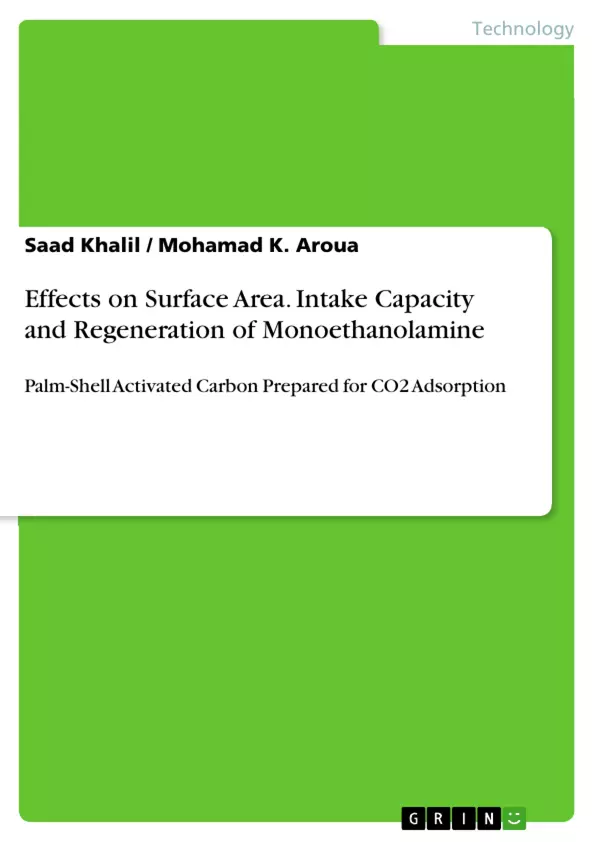Granular palm shell activated carbon (AC) was impregnated separately with monoethanolamine (MEA) and 2-amino-2-methyl-1-propanol (AMP) to improve its natural capacity and selectivity for carbon dioxide (CO2) adsorption. The total surface area, micropore volume, as well as the heterogeneity of the impregnated AC particles was considerably reduced due to impregnation. CO2 intake of impregnated 500 μm AC particles improved significantly and adsorptive capacity of 500 μm MEA-impregnated AC particles improved by 172 % and 44 % comparing to non-impregnated and AMP-impregnated AC particles respectively. Solid state amine stoichiometric results indicated that adsorption capacity of unhindered amine (MEA) is higher than that of hindered amine (AMP) by 50 % contrary to liquid amines standard stoichiometry. Exhausted AMPimpregnated beds were regenerated by sweeping at room temperature with stream of pure nitrogen (N2) flowing at 60 ml/min for 4 hours. Heating up to 75 °C was required to regenerate exhausted MEA-impregnated beds. Increasing feed gas flow rate has adverse effect on breakthrough time more than increasing bed operating temperature. Breakthrough time was utilized to evaluate the performance of the different adsorption beds.
Inhaltsverzeichnis (Table of Contents)
- Introduction
- Materials and Methodology
- Materials
- Analytical grade monoethanolamine and 2-amino-2-methyl-1-propanol
- Palm shell AC
- Gases
- Methodology
- AC samples characterization
- MEA and AMP selection
- Impregnation of AC samples
- Adsorption of CO2
- Evaluation method of the adsorption beds performance
- Materials
- Results and Discussion
- Breakthrough time results
- Dynamic adsorption beds capacity improvement
- Unhindered MEA and hindered AMP stoichiometry
- Adsorption isotherm of impregnated and non-impregnated 500 μm AC beds
- Linear regression of Dubinin-Astakhov (D-A) equation
- Thermal characterization of the AC beds
- Effect of regeneration with high temperature on the performance of MEA- impregnated AC beds
- Acknowledgment
- References
Zielsetzung und Themenschwerpunkte (Objectives and Key Themes)
The objective of this work is to investigate the effects of impregnation with monoethanolamine (MEA) and 2-amino-2-methyl-1-propanol (AMP) on the adsorption properties of palm shell activated carbon (AC) for CO2 capture. The study aims to explore the impact of impregnation on surface area, intake capacity, and regeneration of the AC material.
- CO2 adsorption using impregnated activated carbon
- Impact of MEA and AMP impregnation on AC properties
- Comparison of adsorption capacity and stoichiometry of MEA and AMP
- Regeneration of exhausted AC beds
- Dynamic adsorption bed performance evaluation using breakthrough time
Zusammenfassung der Kapitel (Chapter Summaries)
The introduction discusses the importance of CO2 capture and sequestration to address climate change and global warming. It highlights the advantages of adsorption as a CO2 capture technique and emphasizes the potential of activated carbon (AC) as a cost-effective adsorbent. The study focuses on impregnation of palm shell AC with MEA and AMP to enhance its CO2 adsorption capacity.
Chapter 2 details the materials and methods employed in the study. This includes the characterization of the AC material, the selection of MEA and AMP, the impregnation process, the CO2 adsorption experiments, and the evaluation method using breakthrough time.
Chapter 3 presents the results and discussion. The chapter analyzes the effects of impregnation on surface area, intake capacity, and regeneration of the AC material. It also compares the adsorption capacity and stoichiometry of MEA and AMP. The chapter explores the influence of operating parameters such as feed gas flow rate and bed temperature on breakthrough time.
Schlüsselwörter (Keywords)
The main keywords and focus topics of this work include activated carbon, CO2 adsorption, impregnation, monoethanolamine (MEA), 2-amino-2-methyl-1-propanol (AMP), breakthrough time, dynamic adsorption, and regeneration.
- Arbeit zitieren
- Saad Khalil (Autor:in), Mohamad K. Aroua (Autor:in), 2018, Effects on Surface Area. Intake Capacity and Regeneration of Monoethanolamine, München, GRIN Verlag, https://www.hausarbeiten.de/document/437683


